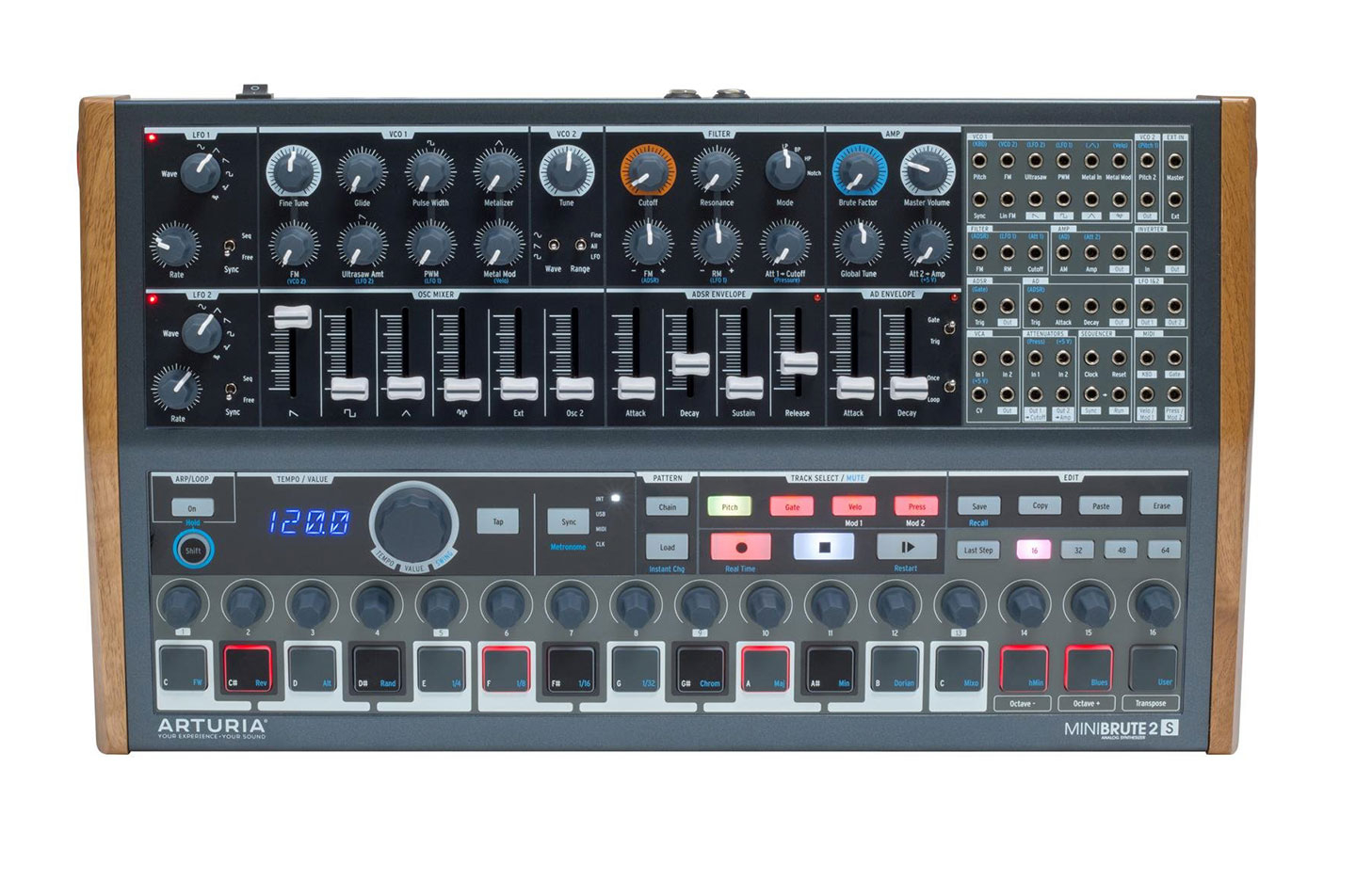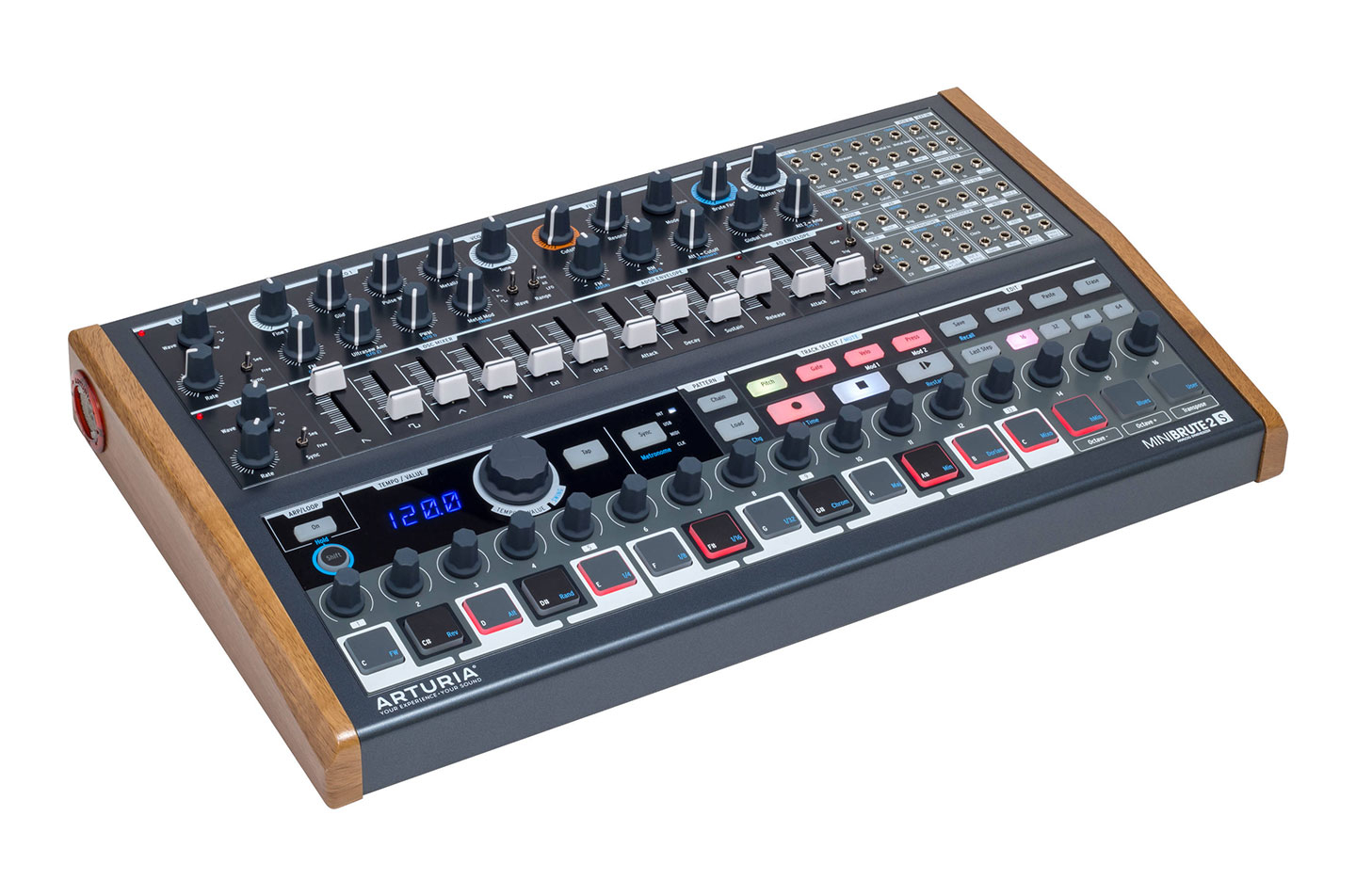- A powerful analogue synth with bonus Eurorack capabilities and a competitive price.
- The MiniBrute 2S bears little resemblance, physically or sonically, to its forbearer. It was launched earlier this year as part of Arturia's RackBrute system alongside the MiniBrute 2 and two Eurorack cases, all of which can be mounted and transported together. Despite having "mini" in its name, the MiniBrute 2S is a hefty piece of kit that feels destined for the studio rather than the gig bag (still, it is slightly lighter than the original model). The main difference between the 2S and the regular MiniBrute 2 is that the latter's 25-key keyboard has been swapped out for a rather clunky-looking but capable step sequencer.
Because of how different the MiniBrute 2S is from its predecessor, it's worth treating it as a whole new synthesiser rather than simply noting changes. At its heart is the main VCO, which has sawtooth, square and triangle wave outputs. All three waveforms are simultaneously accessible and can be mixed together via short-throw faders. The VCO has controls for fine-tuning, frequency modulation (sourced from VCO 2), glide, the chorus-like Ultrasaw effect, pulse-width as well as PWM and Metallizer/Metal Mod, which is roughly Arturia's take on triangle wavefolding. There's a second VCO as well, but it only has a tuning knob (switchable between LFO-range, coarse and fine tuning), and a waveform selection switch (sine, saw, square). VCO 2 tracks VCO 1's pitch by default, but this can be overridden in the patch bay. VCO 2's signal is also available via fader in the Osc Mixer section, in addition to a noise source and external input.
The MiniBrute also has two identical dedicated LFOs, switchable between six waveforms, including highly useful stepped and gliding random options. While they can run free or sync to the internal clock, I was disappointed to find none of the LFOs' parameters are accessible on the patch bay, meaning you can't clock them to external sources.
Next in the signal chain is the Steiner-Parker filter, operating in low-pass, band-pass, hi-pass or notch mode. Along with the obligatory knobs for cutoff and resonance, there are controls for resonance modulation, an additional cutoff frequency and filter modulation. The latter is misleadingly labeled FM—at first glance, I was hoping for pre-configured audio rate modulation, but alas, the pre-patched mod source is a one-shot ADSR envelope.
Finally, we come to the amplification section, where global tuning and "Brute Factor" can be dialed in. There are two envelope generators on hand, the aforementioned ADSR and an attack-decay envelope, which can be toggled between one-shot and looping as well as gated and triggered operation. The AD envelope is the default control for overall amplification, with attack and decay times from 1ms to 14 seconds. On the patch bay, there's an AM input for breaking this connection and using a different amp control source.
Up to here, the Minibrute 2S is a simple but flexible monosynth (or duophonic with some clever patching). But the sequencer that dominates the bottom half of the machine turns it into an altogether different sort of instrument. The Minibrute's sequencer is intuitive for basic use. Gates are input by activating step buttons, pitches are set with the corresponding knobs. Beyond that, things get a bit hairier. I found the sequencer nearly impossible to effectively program without relying on the manual, which surprised me considering I've spent a lot of time with Arturia's Beatstep and Beatstep Pro sequencers.
The sequencer actually has four tracks per pattern: besides pitch and gate, there's Velo/Mod 1 and Press/Mod 2. These two tracks are by default tied to the main sequencer track, recording and outputting velocity and pressure data. However, they can be separated from the primary sequence by switching their track types. The pitch and gate options are self-explanatory, but envelope and LFO are more esoteric. The former outputs an AD envelope with adjustable attack/decay time for each active step while inputting steps in the latter changes LFO rate and amplitude. When in any of these modes, the Mod tracks can also have their own separate lengths and time divisions. It's a lot to wrap your head around and takes a while to get the hang of, but it makes for an extremely deep and powerful sequencer.
The Minibrute 2S is powerful and versatile, in exactly the way an analogue synth should be. It's easy to find your way around the panel no matter what your level of experience is, and though there are some annoying omissions from the patch bay, it's undeniably a helpful gateway for the Eurorack-curious. Most importantly, the Minibrute 2S sounds good—though the synth's architecture is simple, there's a lot you can do with all that sequencing muscle.
Ratings:
Cost: 4.6
Versatility: 4.2
Ease of use: 4.0
Sound: 4.5
 The sequencer actually has four tracks per pattern: besides pitch and gate, there's Velo/Mod 1 and Press/Mod 2. These two tracks are by default tied to the main sequencer track, recording and outputting velocity and pressure data. However, they can be separated from the primary sequence by switching their track types. The pitch and gate options are self-explanatory, but envelope and LFO are more esoteric. The former outputs an AD envelope with adjustable attack/decay time for each active step while inputting steps in the latter changes LFO rate and amplitude. When in any of these modes, the Mod tracks can also have their own separate lengths and time divisions. It's a lot to wrap your head around and takes a while to get the hang of, but it makes for an extremely deep and powerful sequencer. The Minibrute 2S is powerful and versatile, in exactly the way an analogue synth should be. It's easy to find your way around the panel no matter what your level of experience is, and though there are some annoying omissions from the patch bay, it's undeniably a helpful gateway for the Eurorack-curious. Most importantly, the Minibrute 2S sounds good—though the synth's architecture is simple, there's a lot you can do with all that sequencing muscle. Ratings: Cost: 4.6 Versatility: 4.2 Ease of use: 4.0 Sound: 4.5
The sequencer actually has four tracks per pattern: besides pitch and gate, there's Velo/Mod 1 and Press/Mod 2. These two tracks are by default tied to the main sequencer track, recording and outputting velocity and pressure data. However, they can be separated from the primary sequence by switching their track types. The pitch and gate options are self-explanatory, but envelope and LFO are more esoteric. The former outputs an AD envelope with adjustable attack/decay time for each active step while inputting steps in the latter changes LFO rate and amplitude. When in any of these modes, the Mod tracks can also have their own separate lengths and time divisions. It's a lot to wrap your head around and takes a while to get the hang of, but it makes for an extremely deep and powerful sequencer. The Minibrute 2S is powerful and versatile, in exactly the way an analogue synth should be. It's easy to find your way around the panel no matter what your level of experience is, and though there are some annoying omissions from the patch bay, it's undeniably a helpful gateway for the Eurorack-curious. Most importantly, the Minibrute 2S sounds good—though the synth's architecture is simple, there's a lot you can do with all that sequencing muscle. Ratings: Cost: 4.6 Versatility: 4.2 Ease of use: 4.0 Sound: 4.5